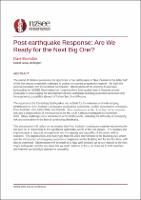| dc.description.abstract | The period of relative quiescence for significant urban earthquakes in New Zealand in the latter half of the last century presented challenges in getting the country prepared to respond – for both the general population and the technical community. Observations of the response to overseas earthquakes by NZSEE Reconnaissance (Learning from Earthquakes) teams however proved invaluable in encouraging the development of post-earthquake building assessment processes and the engineering capability element of Urban Search and Rescue. The response to the Canterbury Earthquakes was notable for the extensive and wide-ranging contribution by New Zealand’s earthquake engineering community, swiftly supported by colleagues from Australia, the United States and Canada. This involvement in the ‘front line’ of the response was also a characteristic of the response to the Hurunui/ Kaikoura earthquake in November 2016. Many challenges were encountered across both events, including the difficulty of conveying risk and uncertainty in the face of continuing aftershocks. This presentation will reflect on the journey that New Zealand’s earthquake engineering community has been on in responding to the significant earthquake events of the past decade. The changes and improvements to response arrangements and the capacity and capability of the sector will be explored. The opportunities and challenges from the 2019 amendments to the Building Act, which saw the introduction of emergency response arrangements in the Building Act for the first time, will also be examined. Observations will be made as to how well prepared we to are respond to the next major earthquake, and the key areas that we must continue to focus on if we are to both maintain and improve our technical operational capability. | |

